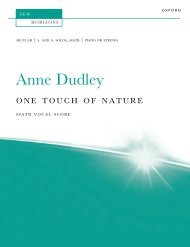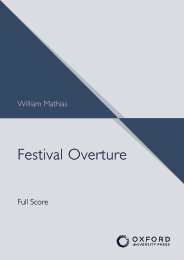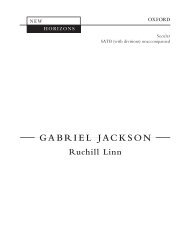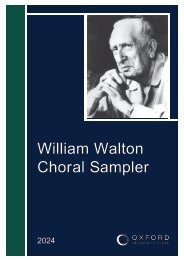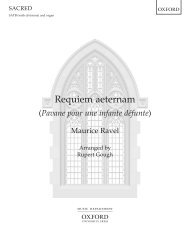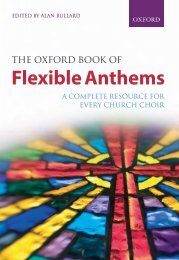New Oxford Organ Method
A single piece of repertoire is the primary focus for each chapter, with preparatory exercises providing the necessary technical work building towards the piece. Each lesson covers four main topics, which are systematically developed: practice methods, registration, fingering and pedalling, and historically-informed interpretation. The method is for keyboard players of any age who are establishing first steps at the organ with or without a teacher. It will also serve more experienced organists who want to improve their technique.
A single piece of repertoire is the primary focus for each chapter, with preparatory exercises providing the necessary technical work building towards the piece. Each lesson covers four main topics, which are systematically developed: practice methods, registration, fingering and pedalling, and historically-informed interpretation. The method is for keyboard players of any age who are establishing first steps at the organ with or without a teacher. It will also serve more experienced organists who want to improve their technique.
- No tags were found...
Create successful ePaper yourself
Turn your PDF publications into a flip-book with our unique Google optimized e-Paper software.
216 new oxford organ method<br />
?# 3<br />
2<br />
?#<br />
Prepare<br />
both feet<br />
-˙<br />
-˙<br />
˙-<br />
m<br />
m ¡<br />
˙ ˙ ˙ ˙<br />
¡ m<br />
˙ ˙<br />
¡<br />
˙ # ˙ ˙<br />
m ¡ m ¡<br />
Knee V-shape to<br />
gauge octave<br />
m<br />
˙ ˙ ˙ ˙ ˙<br />
¡ m ¡ m<br />
˙ ˙ ˙<br />
¡ m ¡<br />
˙ # ˙ ˙ w<br />
m¡ m ¡<br />
m<br />
˙<br />
Retain both<br />
feet on their<br />
previous notes<br />
w Ó Ó<br />
m<br />
Knee V-shape<br />
to gauge 4th<br />
m<br />
∑<br />
m - ˙<br />
Both feet to<br />
home position<br />
?#<br />
?#<br />
Knee V-shape<br />
to gauge 4th<br />
m ¡ m<br />
m<br />
˙<br />
m - ˙ - ˙ - ˙ ˙ ˙ ˙<br />
m<br />
œ œ ˙<br />
¡ m<br />
Ó<br />
Ó<br />
Knee V-shape<br />
to gauge 4th<br />
m<br />
˙ ˙ ˙ œ # œ ˙ ˙<br />
m ¡ m ¡ m ¡<br />
m<br />
Knee V-shape<br />
to gauge<br />
octave<br />
˙<br />
m<br />
m<br />
˙<br />
˙<br />
m<br />
Knee V-shape<br />
to gauge 4th<br />
Knee V-shape<br />
to gauge 5th<br />
m<br />
m<br />
uw<br />
˙<br />
m<br />
(complete pedal part annotated)<br />
for online perusal only<br />
Combining manual techniques in quick succession<br />
Practise these annotated examples, employing Practice strategy 5: Stop and think as necessary to digest the<br />
technical guidance. Practise it thoroughly until you can restore the printed rhythm:<br />
& #<br />
{<br />
?#<br />
3<br />
2<br />
3<br />
2<br />
& # 4<br />
{<br />
?#<br />
4<br />
2<br />
w<br />
Release tenor<br />
C so alto can<br />
replay the note<br />
End of phrase:<br />
breath in all<br />
voices<br />
’<br />
Release<br />
repeated note<br />
3- -<br />
œ œ œ œ ˙ ˙ ˙ œ<br />
Alto passes<br />
between hands<br />
Release soprano<br />
G because of the<br />
tenuto mark 1<br />
œ œ œ œ ˙ œ œ œ œ œ œ<br />
2 3<br />
5<br />
Bracket Double finger<br />
indicates<br />
alto in LH 35 substitution<br />
23<br />
Independent<br />
rhythm in<br />
alto<br />
Substitution<br />
34 1 3 2 1<br />
˙œ œ ˙ ˙œ œ ˙œ œ ˙œ # œ ˙<br />
œ<br />
# œ œ œ ˙ # ˙ œ bœ<br />
1 2<br />
3<br />
1<br />
˙<br />
˙<br />
œ<br />
œ<br />
(based on bb. 6–9)





